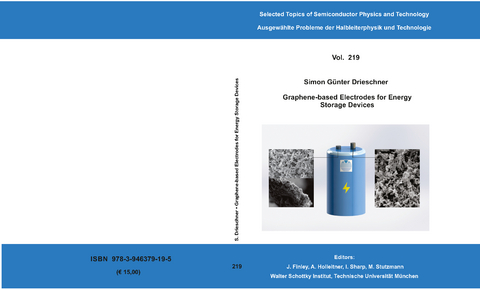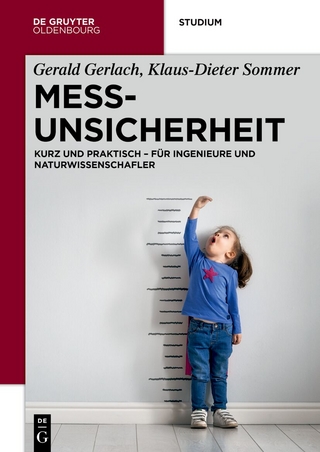
Graphene-based Electrodes for Energy Storage Devices
Seiten
2019
Verein zur Förderung des Walter Schottky Instituts der Technischen Universität München (Verlag)
978-3-946379-19-5 (ISBN)
Verein zur Förderung des Walter Schottky Instituts der Technischen Universität München (Verlag)
978-3-946379-19-5 (ISBN)
- Keine Verlagsinformationen verfügbar
- Artikel merken
Graphene, a planar sheet of carbon atoms arranged in a honeycomb lattice, was deemed as the new ”wonder material“ as it exhibits many unique properties such as mechanical stability, high conductivity, and high specific surface area. ”Graphene foam”, a three-dimensional (3D) structure consisting of graphene layers, combines these outstanding characteristics with the opportunity to obtain a high surface area per unit volume making it a very promising material for energy storage applications. This thesis focuses on the fabrication of such graphene networks and their application in supercapacitors.
The first part addresses the growth of graphene by chemical vapor deposition (CVD) on planar copper (Cu) and nickel (Ni) substrates. On the basis of a few presented growth recipes for single layer graphene (SLG) on Cu, the influence of the growth parameters on the graphene coverage, domain size, and quality is presented using scanning scanning electron microscope (SEM) images and Raman spectroscopy. The growth on Cu is compared to the growth of multilayer graphene films obtained on Ni foil substrates.
The interface between the graphene layers and an electrolyte is discussed in the second part. While a simple Randles circuit can be used to reproduce the frequency response for multilayer graphene, a more detailed model considering the limited density of states around the Dirac point is required for single layer
graphene. An analytical model and a finite element method (FEM) are employed to fit the electrochemical impedance spectroscopy (EIS) data of single layer graphene electrodes and transistors and to extract their gate-voltage dependent interfacial capacitance and intrinsic resistance.
In the third part, methods to grow 3D graphene foams are presented. Instead of exploiting commercially available Ni foams (with pore sizes between 200 and 400 μm) as substrate for the CVD growth of graphene, customized metal foams obtained by sintering Ni or Cu particles at high temperatures are used. Depending on the size of the used metal particles and the growth temperature, the pore sizes can be decreased below 1 μm leading to an increase of the electrochemically available surface area by a factor of 10,000 in comparison to graphene foams grown on commercially available Ni foams. On Cu substrates, the number of graphene layers can be decreased down to one resulting in a high specific capacitance close
to the theoretical limit. Furthermore, the preparation of micro graphene foams (μGFs) with pore sizes and a thickness in the micrometer range is demonstrated using a NiCu alloy foam synthesized by anodic deposition on Ni foil.
This thesis closes with the coating of the as-obtained graphene foams with pseudocapacitively active materials. First, the conductive polymers, polyaniline and polypyrrole, are synthesized on graphene foams grown using Ni particles by cyclic voltammetry comparing their capacitance improvement. Second, μGFs
are coated with MnO2. To obtain a uniform coverage, a method based on square wave voltammetry is developed optimized to the porous nature of the graphene electrode. Finally, the MnO2-coated μGF is used as cathode in an asymmetric supercapacitor with a bare graphene foam as anode.
The first part addresses the growth of graphene by chemical vapor deposition (CVD) on planar copper (Cu) and nickel (Ni) substrates. On the basis of a few presented growth recipes for single layer graphene (SLG) on Cu, the influence of the growth parameters on the graphene coverage, domain size, and quality is presented using scanning scanning electron microscope (SEM) images and Raman spectroscopy. The growth on Cu is compared to the growth of multilayer graphene films obtained on Ni foil substrates.
The interface between the graphene layers and an electrolyte is discussed in the second part. While a simple Randles circuit can be used to reproduce the frequency response for multilayer graphene, a more detailed model considering the limited density of states around the Dirac point is required for single layer
graphene. An analytical model and a finite element method (FEM) are employed to fit the electrochemical impedance spectroscopy (EIS) data of single layer graphene electrodes and transistors and to extract their gate-voltage dependent interfacial capacitance and intrinsic resistance.
In the third part, methods to grow 3D graphene foams are presented. Instead of exploiting commercially available Ni foams (with pore sizes between 200 and 400 μm) as substrate for the CVD growth of graphene, customized metal foams obtained by sintering Ni or Cu particles at high temperatures are used. Depending on the size of the used metal particles and the growth temperature, the pore sizes can be decreased below 1 μm leading to an increase of the electrochemically available surface area by a factor of 10,000 in comparison to graphene foams grown on commercially available Ni foams. On Cu substrates, the number of graphene layers can be decreased down to one resulting in a high specific capacitance close
to the theoretical limit. Furthermore, the preparation of micro graphene foams (μGFs) with pore sizes and a thickness in the micrometer range is demonstrated using a NiCu alloy foam synthesized by anodic deposition on Ni foil.
This thesis closes with the coating of the as-obtained graphene foams with pseudocapacitively active materials. First, the conductive polymers, polyaniline and polypyrrole, are synthesized on graphene foams grown using Ni particles by cyclic voltammetry comparing their capacitance improvement. Second, μGFs
are coated with MnO2. To obtain a uniform coverage, a method based on square wave voltammetry is developed optimized to the porous nature of the graphene electrode. Finally, the MnO2-coated μGF is used as cathode in an asymmetric supercapacitor with a bare graphene foam as anode.
| Erscheinungsdatum | 05.04.2019 |
|---|---|
| Sprache | englisch |
| Maße | 150 x 210 mm |
| Themenwelt | Naturwissenschaften ► Physik / Astronomie |
| Schlagworte | graphene foam • pseudocapacitance • Supercapacitor |
| ISBN-10 | 3-946379-19-2 / 3946379192 |
| ISBN-13 | 978-3-946379-19-5 / 9783946379195 |
| Zustand | Neuware |
| Haben Sie eine Frage zum Produkt? |
Mehr entdecken
aus dem Bereich
aus dem Bereich
von den Werkzeugen über Methoden zum TQM
Buch | Softcover (2024)
Springer Fachmedien (Verlag)
32,99 €
kurz und praktisch - für Ingenieure und Naturwissenschafler
Buch | Softcover (2024)
De Gruyter Oldenbourg (Verlag)
44,95 €


